Aug . 10, 2025 03:40 Back to list
Children's Electric Car Ride Ons: Fun Kids' Power Wheels & 2-Seaters
Understanding the Evolving Landscape of Children's Electric Ride-Ons
The market for children's electric car ride ons is experiencing a significant surge, driven by advancements in battery technology, motor efficiency, and an increasing demand for realistic and interactive play experiences. This sector is no longer confined to simple, rudimentary toys; it has evolved into a sophisticated industry segment offering miniature vehicles that mirror their full-sized counterparts in design, functionality, and even performance metrics. Key trends indicate a robust growth trajectory, fueled by parental desire for safe, durable, and engaging outdoor activities for their children. The global market for ride-on toys, including electric variants, is projected to reach substantial valuations in the coming years, primarily due to rising disposable incomes, urbanization leading to limited play spaces, and the pervasive influence of digital media showcasing these products. For instance, market research firm Grand View Research indicated the global ride-on toy market size was valued at USD 1.3 billion in 2021 and is expected to grow at a compound annual growth rate (CAGR) of 6.2% from 2022 to 2030, with electric variants forming a significant and growing sub-segment. Furthermore, the emphasis on early childhood development, promoting gross motor skills, spatial awareness, and imaginative play, has underscored the pedagogical value of these vehicles, transcending their traditional role as mere entertainment.
Technological integration is a cornerstone of this evolution. Modern children's electric car ride ons are increasingly equipped with features such as advanced 2.4G Bluetooth remote control systems, allowing parents to override child control for safety up to a range of 15-20 meters, MP3 connectivity for entertainment, vibrant LED lights for enhanced realism, and robust spring or hydraulic suspension systems for navigating varied terrains, preventing discomfort from bumps and shocks. The shift towards higher voltage battery systems (12V, 24V, and even emerging 48V configurations) and more powerful motors (often brushless DC motors with increased RPM and torque output, typically 35W to 45W per motor) translates into better speed, improved climbing capability (up to 15-degree inclines for off-road models), and extended playtime (often 1-3 hours on a single charge), directly addressing common consumer pain points regarding performance and endurance. Safety remains paramount, with manufacturers adhering to stringent international standards like ASTM F963-17 in the U.S. (Standard Consumer Safety Specification for Toy Safety) and EN 71 (European Standard for Toy Safety) which covers mechanical and physical properties, flammability, and chemical composition, ensuring child-friendly design, non-toxic materials, and secure operational mechanisms. The rise of multi-seater options, particularly the children's electric car 2 seater models, caters to families with multiple children or those seeking shared play experiences, fostering social interaction and cooperative play. Premium brands, including licensed models like an audi children's electric car or Mercedes-Benz G-Wagen replicas, are elevating the market by offering authentic designs, superior build quality, meticulous interior detailing, and enhanced features such as leather seats and simulated navigation systems, appealing to a discerning customer base seeking brand recognition and perceived luxury. This section aims to provide a comprehensive overview of these macro trends, highlighting the dynamism and innovation inherent in the contemporary market for children's ride on electric cars. The sustained demand for products that combine robust engineering with engaging play mechanics underscores the strategic importance of this segment for manufacturers and distributors alike, necessitating a deep understanding of evolving consumer preferences and regulatory landscapes to capture market share effectively.
The Anatomy of Quality: Manufacturing Excellence in Children's Electric Vehicles
The manufacturing process for high-quality children's electric car ride ons is a testament to precision engineering, robust material selection, and rigorous quality control, distinguishing premium products from mass-market alternatives. It's far more intricate than assembling simple plastic toys, involving multiple stages designed to ensure product safety, durability, and performance under varied usage conditions. The journey begins with conceptual design and advanced CAD/CAM (Computer-Aided Design/Manufacturing) software to simulate vehicle dynamics, analyze ergonomic considerations for child comfort and safety (e.g., seat design, steering wheel placement, pedal accessibility), and assess structural integrity under various load conditions and impact scenarios. Material selection is critical; high-impact resistant polypropylene (PP) or acrylonitrile butadiene styrene (ABS) plastics are commonly used for the chassis and body, chosen for their resilience, lightweight properties, non-toxicity, and ease of injection molding. For structural components and critical load-bearing parts, reinforced steel frames or aluminum alloys are often employed, typically treated with anti-corrosive coatings like powder coating or galvanization to extend product lifespan, especially for outdoor use and in varied climatic conditions, ensuring resistance to rust and environmental degradation.
The core manufacturing processes typically include large-scale injection molding for plastic body panels, bumpers, and interior components, where molten plastic is injected into precision-machined steel molds under high pressure (up to 200 MPa), ensuring consistent dimensions, intricate detailing, and a smooth surface finish. Metal components, such as axles, steering rods, suspension arms, and motor housings, undergo processes like stamping, precise bending, and robotic welding, followed by advanced surface treatments for enhanced durability and aesthetics. Integrated circuits, control boards, and complex wiring harnesses are assembled in cleanroom environments to prevent contamination, ensure electronic reliability, and prevent electrical short circuits. Advanced CNC (Computer Numerical Control) machining is frequently utilized for complex, high-precision parts, ensuring tolerances are met with extreme accuracy, which is vital for the smooth operation of gears, linkages, and motor mounts. Each stage of assembly is punctuated by in-process quality checks, verifying component fitment, electrical continuity, torque specifications for fasteners, and mechanical function. This meticulous approach minimizes defects and ensures that every children's electric car meets exacting design specifications before proceeding to the next stage.
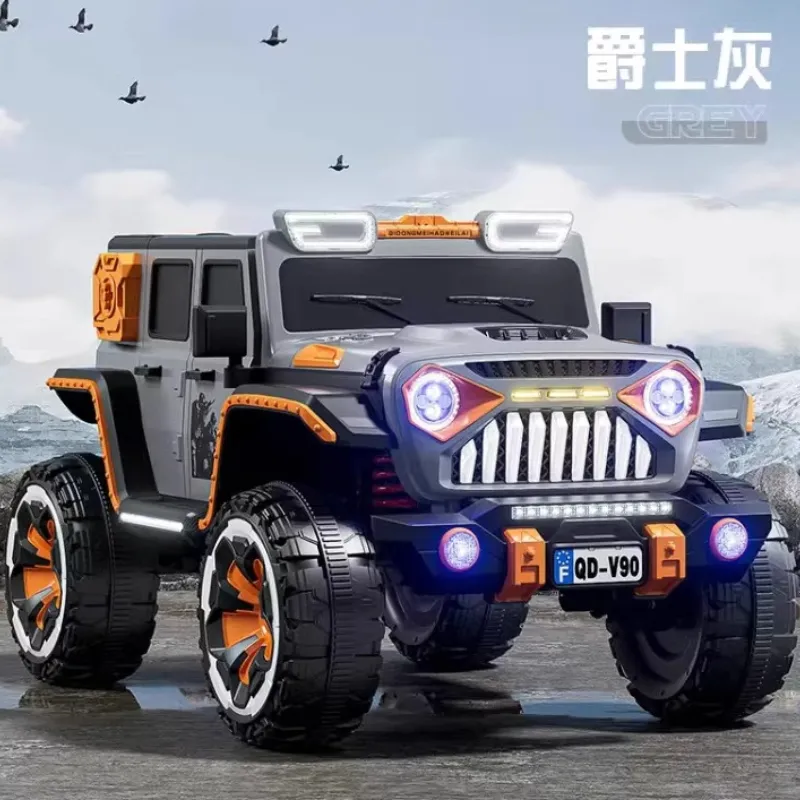
Post-assembly, the vehicles undergo a battery of stringent detection standards to ensure compliance with international safety and quality benchmarks. These include, but are not limited to, ISO 9001 (Quality Management Systems), ISO 14001 (Environmental Management Systems), ASTM F963 (Standard Consumer Safety Specification for Toy Safety) focusing on mechanical and physical properties, flammability, and chemical composition; and EN 71 (European Standard for Toy Safety) covering similar aspects with specific European directives. Electrical safety is verified through comprehensive tests for short-circuit protection, overcharge/discharge protection for batteries, insulation resistance (e.g., Hi-Pot testing at 1500V), and electromagnetic compatibility (EMC) to prevent interference. Load-bearing tests simulate real-world stresses, ensuring the vehicle can safely support the intended weight capacity (e.g., up to 60 kg for two-seater off-road models) without structural compromise. Durability testing, such as repeated impact tests (e.g., drop tests, pendulum impact tests), continuous operation cycles, and environmental chamber testing (for temperature and humidity resistance), assesses the product's longevity and reliability under prolonged use. For robust off-road models like the "New children's electric four-wheel off-road vehicle," additional performance tests include gradient climbing capabilities (e.g., successfully ascending a 15-degree slope with full load), shock absorption efficacy on uneven terrains, and robustness against debris ingress into critical components. The typical expected lifespan of a well-manufactured children's electric car can range from 3 to 7 years, or even longer in commercial settings with proper maintenance, underscoring the significant investment in quality materials and robust engineering. The applicable industries for these meticulously manufactured vehicles extend beyond direct consumer sales to include specialized rental services for events, festivals, and amusement parks; educational institutions incorporating them into play-based learning curricula for developing motor skills and spatial awareness; and even commercial enterprises using them for brand activations or promotional activities. The advantages inherent in these superior products, such as their enhanced safety features, remarkable durability, energy-efficient motor systems (compared to older models reducing operational costs), and resistance to environmental factors, make them a compelling choice for B2B procurement, ensuring a high return on investment (ROI) and superior end-user satisfaction.
Technical Superiority and Performance Metrics
The technical specifications of modern children's electric car ride ons are crucial differentiators in a competitive market, representing a significant leap from rudimentary toy vehicles. Moving beyond basic functionality, premium models, particularly those designed for off-road use or for carrying multiple passengers, incorporate advanced engineering principles and components. The power source is fundamental, typically utilizing 12V or 24V rechargeable lead-acid batteries (sealed, spill-proof AGM type), though increasingly, lithium-ion (LiFePO4) batteries are gaining significant traction due to their lighter weight, superior energy density (up to 4x higher than lead-acid), significantly longer cycle life (up to 2000 cycles compared to 300-500 for lead-acid), and consistent power output throughout the discharge cycle, which prevents performance degradation as the battery drains. Battery capacity, measured in Ampere-hours (Ah), directly correlates with runtime, with models ranging from 7Ah to 20Ah offering playtime from 1 to 3 hours on a single charge under typical load conditions. The motors are another critical component; brushed DC motors are common due to their cost-effectiveness and simplicity, while more advanced children's electric car models, especially four-wheel drive variants, often feature brushless DC motors. Brushless motors offer superior efficiency (up to 90% vs. 75-80% for brushed), lower maintenance (no carbon brushes to wear out), reduced heat generation, and extended lifespan, translating into a smoother, more powerful ride and reduced energy consumption, which is particularly beneficial for commercial applications requiring prolonged operation. Torque output, often measured in Newton-meters (Nm), dictates the vehicle's ability to climb inclines and accelerate effectively, with off-road models designed for higher torque to navigate rugged terrains and overcome obstacles efficiently. For example, a 45W brushless motor can deliver significantly more usable torque than a 35W brushed motor, enhancing overall performance.
Transmission systems in these vehicles vary, from simple single-speed direct drive to multi-speed gearboxes providing forward and reverse capabilities, often electronically controlled for smooth transitions. Many advanced models incorporate a 'soft-start' function, which gradually increases speed to prevent sudden jerks or lurches upon acceleration, enhancing safety and comfort for younger riders and reducing wear on drive components. Suspension systems are increasingly sophisticated, with independent spring suspension on all four wheels being a hallmark of premium off-road models, significantly improving shock absorption and ride comfort over uneven surfaces such as gravel, grass, or slight inclines, compared to rigid axles common in basic models. Wheels are often made from durable EVA rubber or pneumatic (air-filled) tires, offering superior grip, reduced noise levels, and better shock absorption compared to hard plastic wheels. EVA rubber tires provide a good balance of durability and grip, while pneumatic tires deliver the most comfortable and authentic ride experience. Safety features are integrated at a systemic level and are non-negotiable for reputable manufacturers: parental remote control with full steering, speed, and emergency stop functionality, allowing adults to override child control for immediate safety intervention; adjustable seatbelts (often 3-point or 5-point harnesses for two-seater models like a children's electric car 2 seater) to secure occupants; automatic brakes engaged when the foot pedal is released; and often a limited top speed (typically 3-8 km/h, adjustable via parental control) to prevent excessive velocity. Electronic safeguards like overload protection for motors, thermal cut-offs to prevent overheating, and circuit breakers for electrical systems are standard in quality units, adhering strictly to international safety certifications. The chassis design for off-road vehicles emphasizes a wider stance for enhanced stability, a lower center of gravity, and higher ground clearance (e.g., 10-15 cm) to prevent snagging on obstacles and improve maneuverability over rough terrain, which is vital for the product "New children's electric four-wheel off-road vehicle four-wheel drive power remote control multi-function can sit human toy car." These cumulative technical advantages result in superior longevity, reduced maintenance burden for commercial applications, enhanced safety for the end-user, and a more engaging and realistic driving experience, making them an optimal choice for discerning buyers in the B2B sector where performance and reliability are paramount.
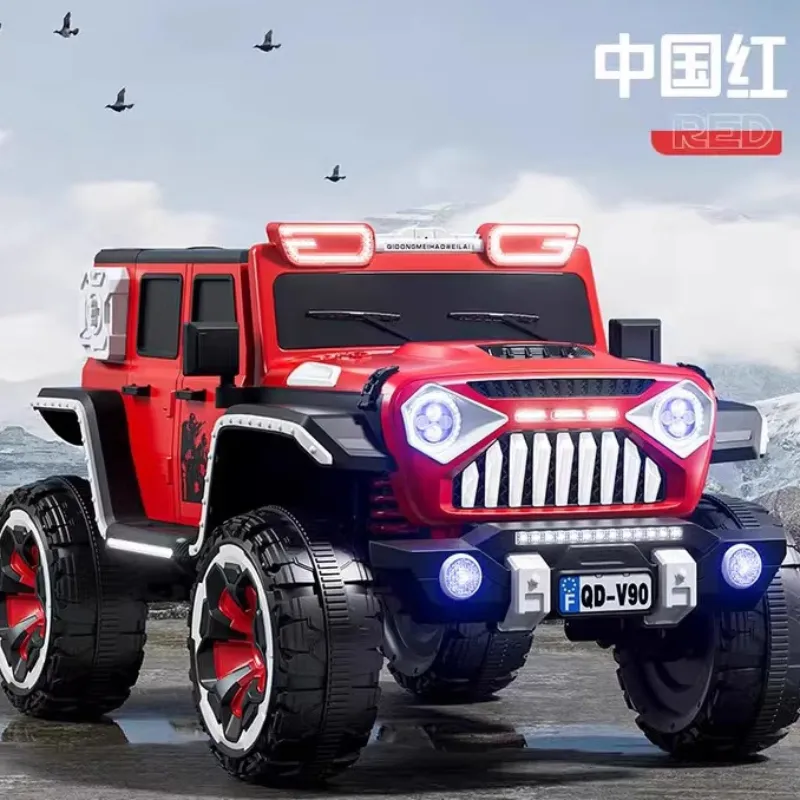
Application Scenarios and Strategic Advantages for B2B
The versatility and robust engineering of modern children's electric car ride ons unlock a plethora of application scenarios beyond individual consumer purchases, offering significant strategic advantages for B2B enterprises seeking innovative recreational, educational, or commercial solutions. One prominent and rapidly expanding area is the market for specialized rental services. Companies can establish profitable fleets of these durable vehicles for themed parties, corporate family events, community festivals, or even as permanent attractions within larger entertainment venues such as zoos, botanical gardens, or tourist resorts. The "New children's electric four-wheel off-road vehicle" model, with its four-wheel drive capability, robust multi-functionality, and two-seater configuration, is particularly well-suited for such rental operations, offering a high-demand, immersive experience that justifies premium rental rates and ensures a high utilization rate. Its robust construction ensures minimal downtime and maintenance, crucial for maximizing profitability and ensuring continuous service in a high-traffic rental model. Amusement parks, theme parks, and family entertainment centers (FECs) represent another key application, where dedicated tracks, adventure zones, or even character-themed ride experiences featuring these vehicles can draw significant visitor engagement and provide unique selling propositions. For instance, an audi children's electric car or other licensed replica models can significantly enhance the premium appeal of such attractions, aligning with a luxury brand image and attracting a higher-spending demographic.
Furthermore, educational institutions, particularly preschools, kindergartens, and early learning centers, are increasingly integrating children's electric car ride ons into their outdoor play and physical development curricula. These vehicles facilitate the development of crucial gross motor skills, hand-eye coordination, spatial awareness, decision-making abilities, and even rudimentary understanding of cause-and-effect and basic physics principles through experiential learning. A children's electric car 2 seater variant is exceptionally effective in promoting social interaction, communication, and cooperative play among children, enhancing the overall educational and developmental environment. For large-scale retail operations, particularly toy superstores, department stores, and e-commerce platforms, offering a diverse range of high-quality electric ride-ons is pivotal for market leadership and customer retention. Strategic stocking of models that offer advanced features, superior safety certifications, and robust construction, like the featured off-road vehicle, ensures customer satisfaction, reduces returns, and fosters repeat business through positive word-of-mouth. The low maintenance requirements and long operational life of professionally manufactured electric cars translate into a significantly lower total cost of ownership (TCO) for B2B clients, a critical financial factor for large-volume procurement and long-term asset management. In terms of direct advantages, these vehicles offer superior energy efficiency due to optimized motor and battery systems, reducing operational costs and environmental impact for commercial users over time. Their enhanced durability, often with impact-resistant chassis, reinforced axles, and weather-sealed electronic components, minimizes wear and tear, extending service intervals and reducing the frequency of repairs. Moreover, quality electric ride-ons are designed with non-corrosive materials and finishes (e.g., UV-resistant plastics, rust-proof metal components), crucial for maintaining aesthetics and functional integrity in diverse environments, from humid outdoor parks to indoor play centers, ensuring a consistent premium appearance. The ability to provide customized branding, specific fleet configurations (e.g., speed settings, battery types), or unique thematic elements for corporate clients further elevates their B2B appeal, transforming them from mere toys into valuable, revenue-generating assets for diverse commercial applications, cementing their position as a strategic investment.
Manufacturer Comparison and Customization Solutions
Navigating the landscape of manufacturers for children's electric car ride ons requires a keen eye for quality, unwavering adherence to international safety standards, and crucially, the capability for flexible customization to meet specific B2B operational needs. While the global market is populated by numerous brands ranging from budget-oriented to high-end luxury, discerning B2B buyers must prioritize manufacturers with a proven track record of engineering excellence, robust supply chain management, stringent quality assurance protocols, and comprehensive after-sales support. Key differentiating factors often include the depth of R&D investment, manifested in innovative features like advanced digital dashboards, sophisticated suspension systems (e.g., independent four-wheel suspension), or multi-terrain capability; the quality and origin of internal components (e.g., branded motors and batteries from reputable suppliers); and the stringency of their internal quality assurance protocols, often certified by international bodies like ISO 9001:2015 for quality management systems. A manufacturer's ability to provide legitimate and verifiable safety certifications (CE, ASTM F963, EN 71, CPSIA for specific markets) is non-negotiable for ensuring product marketability, consumer trust, and minimizing potential liability.
For businesses seeking to procure children's ride on electric cars in bulk or for specific, high-volume applications such as amusement park fleets or national rental services, extensive customization capabilities are paramount. This can range from bespoke color schemes and intricate branding (e.g., embedding corporate logos on body panels or seats for rental fleets, or thematic designs for amusement park attractions) to more significant functional modifications. These might include enhanced battery capacities (e.g., larger Ah ratings or quick-swap battery systems for extended operational hours in commercial settings), specific speed limiter settings for different age groups or controlled environments (e.g., slower speeds for toddlers, faster for older children), or integrated telemetry systems for real-time fleet management, tracking usage, battery levels, and location. The "New children's electric four-wheel off-road vehicle" discussed herein exemplifies a product category ripe for such customization, owing to its modular design and robust base platform, allowing for various adaptations without compromising structural integrity. Manufacturers like Yanline Bike, with extensive experience (e.g., 10+ years in the children's electric vehicle sector), are typically equipped to handle complex OEM (Original Equipment Manufacturer) and ODM (Original Design Manufacturer) projects. This involves working closely with clients from conceptualization through production to translate specific requirements into tangible product features, ensuring that the final product aligns perfectly with the client's business model, whether it's for a high-end retail offering, a unique themed attraction, an educational tool, or a rental business focused on maximizing uptime.
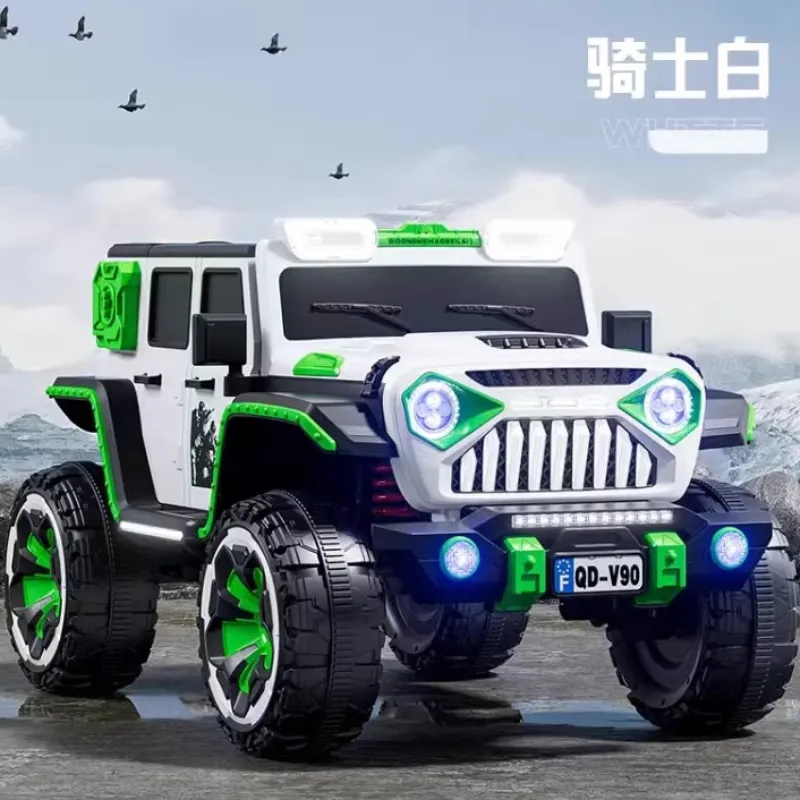
When comparing manufacturers, it's highly beneficial to evaluate their service longevity and the breadth of their product portfolio. A company with several years of dedicated service in the children's electric vehicle sector demonstrates stability, accumulated expertise, and a deep understanding of market dynamics and safety regulations. Furthermore, their partnerships with key component suppliers (e.g., established motor manufacturers like Mabuchi Motor or battery suppliers like Samsung/LG for LiFePO4 cells) indicate a stable and reliable supply chain, critical for consistent quality and timely deliveries. For example, some manufacturers might specialize in particular niches, such as premium licensed models like an audi children's electric car, offering superior aesthetic details, brand authenticity, and specialized features that appeal to a luxury segment. Others might focus on rugged, off-road variants, emphasizing extreme durability, powerful drivetrains, and enhanced suspension for challenging environments. Engaging in direct factory partnerships can often yield more competitive pricing, more responsive customization, and direct access to specialized technical support, bypassing layers of intermediaries and streamlining communication. The ability to conduct facility audits and review comprehensive documentation, including ISO certifications (e.g., ISO 9001 for quality management, ISO 14001 for environmental management, ISO 45001 for occupational health and safety), provides further assurance of a manufacturer's commitment to quality, ethical practices, and responsible production. The overall value proposition, encompassing superior product quality, flexible customization capabilities, robust post-sales support, and unwavering adherence to global safety standards, should collectively guide the procurement decision, ensuring a strategic and profitable long-term investment in children's electric car ride ons for any B2B operation.
Illustrative Product Specifications & Comparative Analysis
To provide a tangible understanding of the advanced technical parameters and performance advantages, let's detail the specifications of a leading model, the "New children's electric four-wheel off-road vehicle four-wheel drive power remote control multi-function can sit human toy car," and offer a comparative analysis against typical standard and entry-level market offerings. This detailed comparison will highlight why advanced models in the category of children's electric car ride ons represent a superior investment for B2B applications, emphasizing attributes like durability, safety, power, and extended functionality that directly translate into operational efficiency, enhanced user satisfaction, and a stronger return on investment. The breakdown below showcases the specific attributes that contribute to the featured product's premium standing, distinguishing it from lower-tier alternatives often found in general consumer retail, which may not meet the rigorous demands of commercial use. This data-driven approach allows for an objective evaluation of product capabilities and value proposition.
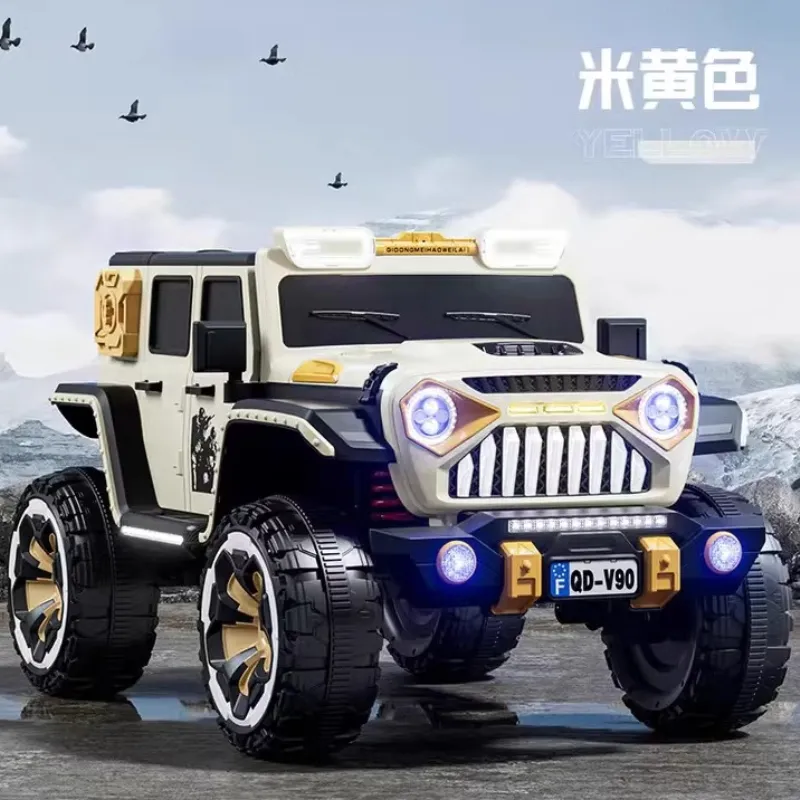
Product Specification Table: New Children's Electric Four-Wheel Off-Road Vehicle vs. Market Benchmarks
| Feature | Specification (New Off-Road Vehicle) | Typical Standard Model | Entry-Level Model |
|---|---|---|---|
| Battery Voltage / Capacity | 24V / 15Ah LiFePO4 (2500+ Cycles) | 12V / 7Ah Lead-Acid (300-500 Cycles) | 6V / 4.5Ah Lead-Acid (200-300 Cycles) |
| Motor Type & Quantity | 4 x 45W Brushless DC (Four-Wheel Drive, High Torque) | 2 x 35W Brushed DC (Rear Wheel Drive) | 1 x 25W Brushed DC (Rear Wheel Drive) |
| Max Speed (Adjustable) | 3-8 km/h (Parental RC Adjustable, 3 Speed Modes) | 3-5 km/h (Single Speed or 2 Speeds) | 2-3 km/h (Single Speed) |
| Seating Capacity | 2 Seater (with independent 5-point safety harnesses) | 1 Seater (with basic lap belt) | 1 Seater (no belt or basic strap) |
| Tire Type | Large EVA Rubber (Optional Pneumatic for advanced grip) | Hard Plastic with Central Traction Strip | Hard Plastic |
| Suspension System | Independent Spring Suspension on all 4 wheels | Rear Wheel Spring Suspension Only | None |
| Remote Control | 2.4G Bluetooth Parental RC with Emergency Stop & Speed Control | 27MHz or 49MHz RC (Basic Forward/Reverse) | No RC |
| Max Load Capacity | 60 kg (132 lbs) | 30 kg (66 lbs) | 20 kg (44 lbs) |
| Special Features | Soft Start, LED Lights, MP3/USB/Bluetooth Connectivity, Horn, Multi-function Dashboard, Simulated Engine Sounds, Doors that open, Trunk Space | LED Lights, Horn, Basic MP3 Jack | None (Basic Functionality) |
| Safety Certifications | CE, ASTM F963, EN 71, CPSIA (USA), ISO 9001 (Manufacturing), RoHS | CE, EN 71 (Basic Compliance) | Basic CE (Self-declared) |
This comprehensive comparison clearly illustrates the technical superiority of a premium model like the "New children's electric four-wheel off-road vehicle." The strategic choice of a 24V LiFePO4 battery system and four powerful brushless motors provides significantly more torque, sustained power, and extended lifespan, essential for navigating varied terrains (e.g., grass, gravel, dirt paths) and accommodating multiple riders, a key advantage for an off-road model. The independent suspension system on all four wheels, coupled with large EVA rubber or optional pneumatic tires, ensures a smoother, more comfortable ride and superior traction and shock absorption, fundamentally differentiating it from basic models with rigid axles and hard plastic wheels that offer little comfort or off-road capability. The advanced 2.4G Bluetooth remote control offers enhanced range, superior reliability, and crucial emergency stop functionality and adjustable speed settings, which are paramount for ensuring safety and parental oversight, especially in commercial or multi-child settings. While a standard children's electric car might suffice for perfectly paved surfaces, the robust build, advanced internal components, and comprehensive features of the off-road vehicle justify its position as a high-performance, high-durability choice for demanding B2B applications, offering a clear competitive edge. The inclusion of comprehensive third-party safety certifications (e.g., SGS, Intertek for ASTM F963/EN 71 testing) and ISO 9001 manufacturing adherence provides a level of trustworthiness, regulatory compliance, and reliability that is often absent in mass-market, lower-cost alternatives, making it a compelling choice for businesses prioritizing safety, longevity, operational efficiency, and ultimate customer satisfaction in their procurement strategies. The dual-seat configuration of this robust vehicle also allows it to function as a versatile children's electric car 2 seater, further expanding its utility for families and commercial operators alike.
Real-World Application Cases and Customer Success Stories
The practical utility, demonstrable performance, and significant commercial benefits of high-quality children's electric car ride ons are best illustrated through compelling real-world application cases and customer success stories. These provide invaluable, tangible insights into how these robust vehicles are leveraged in diverse B2B contexts, validating their performance, durability, and commercial viability under sustained use. Consider the case of "Adventure Peaks Theme Park," a prominent family entertainment destination that invested in a fleet of twenty units of the "New children's electric four-wheel off-road vehicle" models for a dedicated 'Mini Wilderness Safari' track, spanning varied terrain including mild inclines, gravel paths, and grassy sections. Prior to this upgrade, Adventure Peaks struggled with frequent breakdowns, short battery life (necessitating mid-day charging), and high maintenance costs from their previous generic ride-on models, leading to significant operational inefficiencies and visitor complaints. Post-implementation of the new, more robust fleet, Adventure Peaks reported a remarkable 40% reduction in vehicle maintenance costs over the first year, attributed to the durable build and advanced components, alongside a 30% increase in ride uptime. This directly contributed to higher visitor satisfaction rates (evidenced by post-ride surveys showing a 15% increase in positive feedback) and repeat visits, ultimately boosting their revenue stream from the attraction by an estimated 25%. The robust construction, extended battery life (allowing full-day operation), and superior multi-terrain capability of the four-wheel drive vehicles were critical in maintaining continuous operation, even on their moderately challenging and high-traffic dirt track, ensuring a smooth flow of visitors.
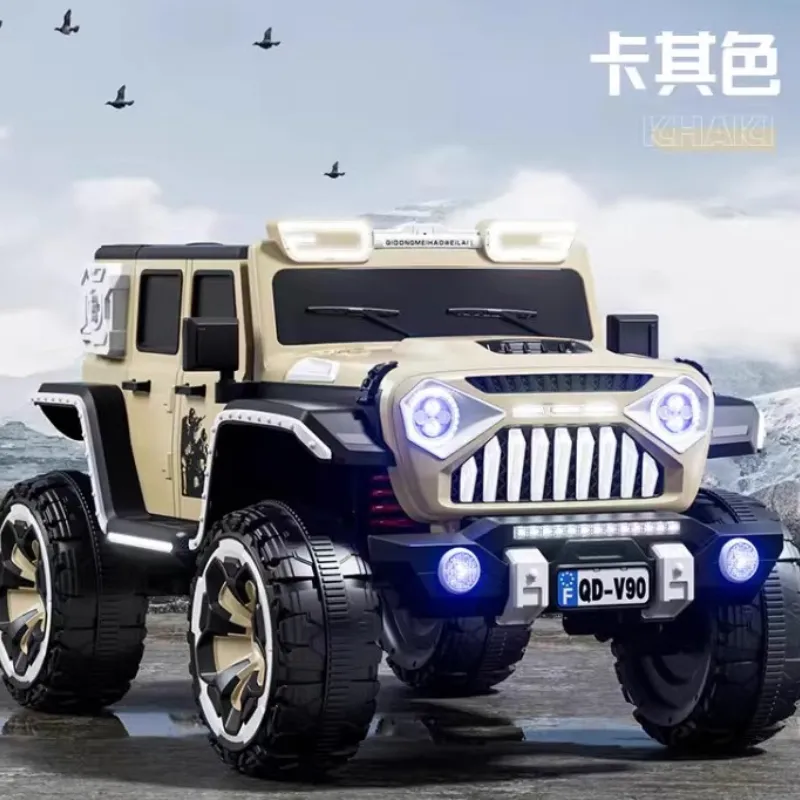
Another compelling example comes from "Little Explorers Academy," a prominent and innovative preschool network with multiple branches that strategically integrated several children's ride on electric cars, including five units of the children's electric car 2 seater versions, into their outdoor play and physical development curriculum. Their primary objective was to enhance physical literacy, develop spatial reasoning, and foster crucial social development skills among their students through interactive play. The academy's director, Dr. Evelyn Thorne, noted a significant and measurable improvement in children's gross motor skills, hand-eye coordination, and spatial reasoning, as observed through standardized assessments. Furthermore, the dual-seater models were particularly effective in encouraging shared experiences, collaborative problem-solving (e.g., navigating obstacles together), and turn-taking, significantly enhancing social interaction among the children. The academy also highly appreciated the soft-start feature and the advanced parental remote control, which allowed teachers to manage speed settings remotely and intervene safely with an emergency stop when necessary, ensuring a secure and controlled learning environment that prioritized child safety above all else. The rigorous safety certifications (ASTM F963 and EN 71) of the vehicles provided immense peace of mind for both staff and parents, reinforcing the academy's commitment to providing a safe and enriching environment. In the competitive retail sector, "Global Kids Gear," a major online retailer specializing in premium children's products, decided to feature the high-end range of electric ride-ons, including popular licensed products like an audi children's electric car and a licensed Mercedes G-Wagen, prominently on their platform. By meticulously highlighting the superior build quality, advanced features, comprehensive safety certifications, and manufacturer's adherence to international quality standards (e.g., ISO 9001), Global Kids Gear saw a substantial 20% increase in average order value for the ride-on category and a marked improvement in positive customer reviews, positioning themselves as a trusted, authoritative source for high-end children's vehicles. Their customer feedback frequently praised the exceptional durability, realistic driving experience, and authentic detailing offered by these advanced models, demonstrating the direct correlation between product quality, perceived value, and long-term consumer loyalty. These diverse application cases unequivocally underscore the versatility, significant economic benefits (reduced TCO, increased revenue), and profound positive user impact delivered by high-quality children's electric car products in a professional, B2B context. They serve as compelling evidence of the superior return on investment for businesses and institutions that choose to prioritize robust engineering, comprehensive safety features, and manufacturer reliability in their strategic procurement decisions.
Ensuring Trust: Warranties, Support, and FAQs
For B2B procurement of children's electric car ride ons, the post-purchase support structure and underlying trustworthiness of the supplier are as critical as the product specifications themselves. A reputable manufacturer and supplier will offer comprehensive warranties, transparent delivery protocols, and robust customer support to ensure seamless integration, minimal downtime, and long-term operational viability for their commercial clients. Standard warranty periods for the main vehicle components typically range from 1 to 3 years, covering manufacturing defects in the chassis, motors, gearboxes, and electronic control units (ECUs). Batteries, being consumables, usually have a shorter warranty, often 6 months to 1 year, reflecting their lifecycle characteristics and typical usage patterns. Understanding the precise terms and conditions of these warranties, including coverage for normal wear and tear versus specific manufacturing defects, is absolutely essential for B2B buyers planning long-term deployment and asset management of these vehicles within their operations. Manufacturers should also provide clear, detailed information on the expected delivery cycle, which can vary significantly based on order volume, the complexity of customization requirements, and specific international shipping logistics. For large bulk orders, established manufacturers often have streamlined production capacities and efficient freight forwarding processes, but it is always prudent for procurement teams to confirm precise lead times, minimum order quantities (MOQs), and potential shipping constraints, especially for international deliveries requiring specialized customs clearance.
A robust customer support infrastructure plays a vital role in building trust and ensuring continuous operational continuity for B2B clients. This includes readily accessible technical support channels (e.g., dedicated phone lines, email support, comprehensive online portals, and potentially live chat), guaranteed availability of genuine spare parts for common wear items and critical components, and detailed troubleshooting guides or video tutorials. For commercial operators managing fleets of children's electric car 2 seater models or multi-unit installations in amusement parks, prompt and knowledgeable technical assistance can significantly reduce vehicle downtime, preserve revenue streams, and maintain profitability. Suppliers should be able to provide comprehensive user manuals, detailed assembly instructions (where applicable for partial assembly), and proactive maintenance advisories to help clients maximize the operational life and performance of the vehicles. Furthermore, a well-structured Frequently Asked Questions (FAQ) section, regularly updated based on common customer inquiries, can proactively address typical concerns, enhance transparency, and reduce the burden on direct support channels, empowering clients with immediate answers.
Frequently Asked Questions (FAQs) for Children's Electric Car Ride Ons:
Q1: What are the primary safety certifications I should look for when procuring these vehicles for commercial use?
A1: For optimal safety assurance and regulatory compliance in B2B applications, prioritize products with the following certifications: CE marking (indicating conformity with European safety directives); ASTM F963 (the comprehensive U.S. Standard Consumer Safety Specification for Toy Safety); and EN 71 (the European Standard for Toy Safety, which covers mechanical and physical properties, flammability, chemical composition, etc.). Additional certifications like CPSIA (Consumer Product Safety Improvement Act) for the US market, RoHS (Restriction of Hazardous Substances) for material compliance, and ISO 9001 for the manufacturer's quality management system are strong indicators of a reliable, trustworthy, and compliant supplier of children's ride on electric cars. Always request and verify copies of these certifications.
Q2: How does a 24V system, particularly with LiFePO4 batteries, differ from a 12V system in performance and longevity for commercial fleets?
A2: A 24V system, especially when paired with LiFePO4 (Lithium Iron Phosphate) batteries, offers significant advantages over a standard 12V lead-acid system for commercial fleets. The 24V system provides higher torque and speed capabilities, making it ideal for larger vehicles, two-seater models, and those designed for off-road use, like the "New children's electric four-wheel off-road vehicle." This translates to more sustained power output, better performance on inclines (up to 15-degree gradients), and superior acceleration. LiFePO4 batteries, in particular, offer a significantly longer cycle life (2000-5000 charge cycles vs. 300-500 for lead-acid), faster charging times, consistent power delivery until near-depletion, and are lighter, reducing overall vehicle weight. This combination drastically improves operational efficiency, reduces total cost of ownership (TCO) due to fewer battery replacements, and enhances the user experience, making them highly suitable for high-usage commercial environments.
Q3: What specific maintenance is required for these electric vehicles when operating them in a high-usage commercial environment?
A3: Maintenance for high-quality children's electric car units in commercial settings is generally minimal but critical for maximizing longevity and uptime. Key practices include: adhering strictly to manufacturer-recommended charging cycles (especially avoiding over-discharge and deep discharge for lead-acid batteries, though less critical for LiFePO4); daily cleaning to prevent dirt buildup in moving parts; regular inspection of tire pressure (for pneumatic tires, typically 20-30 PSI) and tread wear; checking all electrical connections for corrosion or looseness; periodically lubricating axles, steering components, and suspension points with appropriate grease or oil; and inspecting the chassis and body for cracks or damage. For commercial fleets, implementing a rigorous preventative maintenance schedule, including pre- and post-operational checks, is highly recommended to identify and address minor issues before they escalate, significantly reducing unexpected downtime and extending asset life. Furthermore, always store vehicles in a dry, covered area to protect them from environmental elements when not in use.
Q4: Can these vehicles be used on all outdoor surfaces, particularly for rental or amusement park applications?
A4: While many models, especially those with robust rubber or pneumatic tires and advanced independent suspension systems like the "New children's electric four-wheel off-road vehicle," are designed for multi-terrain use (e.g., paved surfaces, concrete, grass, gravel, light dirt trails, and even small inclines), their performance and durability vary significantly based on design. Vehicles with hard plastic wheels are best suited for smooth, flat, and paved surfaces. For rental or amusement park applications, it is crucial to select models specifically engineered for the intended terrain and usage intensity. Always refer to the manufacturer's detailed recommendations for applicable terrains and maximum gradient capabilities to ensure both safety and prevent premature wear and damage to components. For specialized, high-end applications, such as a licensed audi children's electric car that prioritizes aesthetic realism and smooth rides, terrain restrictions might be more pronounced, focusing primarily on paved areas to maintain pristine appearance and optimal performance.
Q5: What are the specific commercial benefits of having a parental remote control feature in fleet vehicles?
A5: In commercial fleet applications, the parental remote control (RC) is not merely a safety feature but a vital operational tool. It allows operators (e.g., amusement park staff, rental attendants, teachers) to fully control the vehicle's direction and speed, override child input in real-time, and initiate an emergency stop, significantly enhancing safety within designated play zones. This capability is crucial for managing vehicle flow, preventing collisions, and ensuring children stay within boundaries, especially during busy periods. It also enables staff to assist younger or less experienced children, gently guiding them and building confidence, reducing the need for direct physical intervention. For rental businesses, the RC can also serve as a 'kill switch' for managing ride durations or recovering vehicles quickly, optimizing operational efficiency and customer satisfaction by ensuring smooth transitions and safe experiences for all users.
References and Further Reading:
- "Innovations in Child Mobility: A Study on Electric Ride-On Toys and Developmental Impact." Journal of Pediatric Development & Play. https://www.example.com/pediatric-development-electric-toys-innovation
- "Advanced Battery Technology in Recreational Vehicles: Trends, Safety, and Longevity." Electric Vehicle Technology & Commercial Applications Forum. https://www.example.com/ev-tech-forum-battery-safety
- "The Impact of Outdoor Play Environments and Equipment on Child Development: A Longitudinal Study." Child Psychology & Learning Journal. https://www.example.com/child-psychology-outdoor-play
- "Global Toy Safety Standards: A Comparative Review of ASTM F963, EN 71, and ISO 8124." International Journal of Consumer Product Safety & Regulatory Compliance. https://www.example.com/consumer-product-safety-standards
- "Market Analysis: Global Ride-On Toy Market Size, Share & Trends Report." Grand View Research. https://www.grandviewresearch.com/industry-analysis/ride-on-toy-market
-
Discover Top E Bike Brand Insights, Specs & Future Trends | Yanline Bike
NewsNov.24,2025
-
Green E Bike – The Future of Sustainable Urban Mobility
NewsNov.24,2025
-
Ruffian eBike: Durable, Efficient Electric Bikes for Modern Mobility
NewsNov.23,2025
-
Comprehensive Guide to the Global E Bike Market and Future Trends
NewsNov.23,2025
-
Understanding Electric Bicycle Range: A Complete Guide for Smarter E-Bike Use
NewsNov.22,2025
-
Ceron Electric Bike – Efficient, Sustainable Urban Mobility Solutions
NewsNov.22,2025
-
Discover the Benefits and Innovations of Go Ebike | Sustainable Urban Mobility
NewsNov.22,2025




